





Can you imagine going from the west coast to the east coast in a matter of hours? Well, on my island, we can!
Welcome on board everyone, we are going right across my island today, setting off in Saint-Pierre and reaching Saint-Benoît about two hours later.
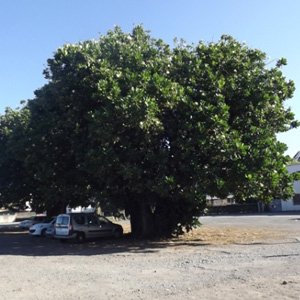 Reading this introduction, you may think that I live on a really tiny island, which is true in a way. But you will soon be amazed by the great many different atmospheres you will experience. No matter that Reunion Island is only twice as big as the city of Los Angeles, we have a lot to show you! The rather young geological history of Reunion (three million years old) explains that we still have an active volcano (the Fournaise volcano) and high mountains which greatly impact weather; the peaks obviously retain rain in the East. The combination of tropical latitude and altimeter diversity leads to so many micro climates that it allows a stunning variety of plant species.
Reading this introduction, you may think that I live on a really tiny island, which is true in a way. But you will soon be amazed by the great many different atmospheres you will experience. No matter that Reunion Island is only twice as big as the city of Los Angeles, we have a lot to show you! The rather young geological history of Reunion (three million years old) explains that we still have an active volcano (the Fournaise volcano) and high mountains which greatly impact weather; the peaks obviously retain rain in the East. The combination of tropical latitude and altimeter diversity leads to so many micro climates that it allows a stunning variety of plant species.
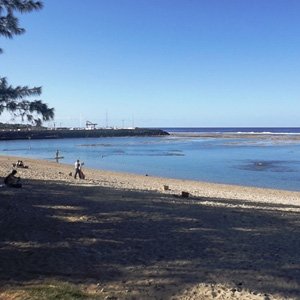 So we start off in Saint-Pierre, often refereed to as the "capitol of the South" whereas Saint-Denis is the real island capitol but set in the northern part. St-Pierre has some 80,000 inhabitants, a rather large harbor with both fishermen and leisure boats. It has an important administrative task with a law court and many official offices. Do not worry, I will not drag you into their offices and stern-looking waiting rooms. Our little journey starts on the beach. And it is a rather large one with white sand and an effective coral reef which keeps sharks at bay, a rather good thing as shark attacks have been growing in number those last years. Even though it is a city beach it is very well kept and the water is pristine. You can enjoy the numerous colorful corals, fishes and other sea creatures, just watch your steps as sea-urchins are also present!
So we start off in Saint-Pierre, often refereed to as the "capitol of the South" whereas Saint-Denis is the real island capitol but set in the northern part. St-Pierre has some 80,000 inhabitants, a rather large harbor with both fishermen and leisure boats. It has an important administrative task with a law court and many official offices. Do not worry, I will not drag you into their offices and stern-looking waiting rooms. Our little journey starts on the beach. And it is a rather large one with white sand and an effective coral reef which keeps sharks at bay, a rather good thing as shark attacks have been growing in number those last years. Even though it is a city beach it is very well kept and the water is pristine. You can enjoy the numerous colorful corals, fishes and other sea creatures, just watch your steps as sea-urchins are also present!
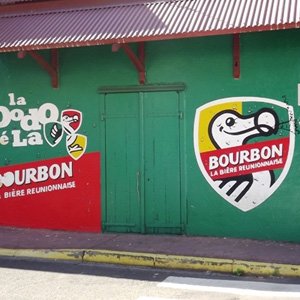 Let us now dry off, have a coffee and a gâteau patate (sweet potato pie) just by the beach and hop into the car which I parked underneath a large sea poison tree (Barringtonia asiatica).
Let us now dry off, have a coffee and a gâteau patate (sweet potato pie) just by the beach and hop into the car which I parked underneath a large sea poison tree (Barringtonia asiatica).
As soon as we head towards the interior of the island, the road gets quite steep. The neighboring town of Le Tampon is only a few kilometers away but it is at 500 meters in elevation. One can soon notice the change in vegetation: flames of the forest (Delonix regia) and golden shower tree (Cassia fistula) which adorn many streets of St-Pierre soon give way to jacaranda (Jacaranda mimosifolia) which require less heat. We will not stop in Le Tampon today, the road to the East drives through and get more and more winding. As this town is extended along the national road, districts are named after the number of kilometers from the sea, hence you can see signals reading 'le onziéme' or 'le dix-septiéme' which means you are at pk.11 or pk.17, not very poetic but quite rational.
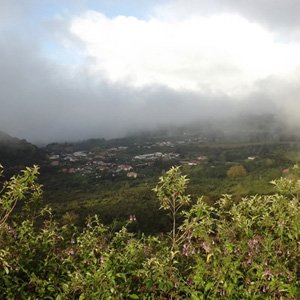
The air becomes somewhat cooler as we now get into Plaine des Caffres, a plateau at a medium level of 1000m. No more banana nor mango trees here, instead you can spot some apple trees, peach trees and the large Japanese pine (Cryptomeria japonica) grown by the ONF (local forest service). We pass by the volcano road which can take you to the lunar landscapes after less than an hour drive. Luckily enough the weather is clear and we can have a fantastic view on the Piton des Neiges, which is the highest point of the island at 3070m high. A few more turns and we already reach the Col de Bellevue (Nice View Pass) at 1630m, where we can stop. We have now gone already across more than half of the island's width and can see the Eastern coast all the way down.
T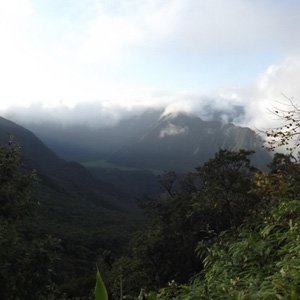 he road worms down through pristine forests mostly made of endemic species among which the noteworthy various tree ferns of the Cyathea genera (C. borbonica, excelsa, glauca). The sides of the road are full of showy large flowers with a sweet scent, but no matter how marvelous they are those plants are nasty invaders; Hedychium flavescens, a member of the ginger family has spread all over and is taking on natural vegetation. On the left side you can spot a narrow road going to the Bébour forest which I will help you discover some other day. After this long winding road we enter the village of Plaine des Palmistes, both sides of the road are now flanked by plane trees (Platanus x hispanica) which yellowing leaves indicate this is autumn. This village is famous for its many old cabins ('cases') with colorful walls and delicate cornices.
he road worms down through pristine forests mostly made of endemic species among which the noteworthy various tree ferns of the Cyathea genera (C. borbonica, excelsa, glauca). The sides of the road are full of showy large flowers with a sweet scent, but no matter how marvelous they are those plants are nasty invaders; Hedychium flavescens, a member of the ginger family has spread all over and is taking on natural vegetation. On the left side you can spot a narrow road going to the Bébour forest which I will help you discover some other day. After this long winding road we enter the village of Plaine des Palmistes, both sides of the road are now flanked by plane trees (Platanus x hispanica) which yellowing leaves indicate this is autumn. This village is famous for its many old cabins ('cases') with colorful walls and delicate cornices.
I suggest we stop and get fruit from this man by the road, those small red fruits grow wild in the area and are really good and full of vitamins and it would be a shame to miss them. Psidium cattleyanum (strawberry guava) was imported from Brazil and has colonized large areas of the island, another invasive species but a rather useful and delicious one, its wood is now used for small furniture. On the eastern outskirts of Plaine des Palmistes the road goes through a peculiar biotope, the 'pandanaie', a spongy area where grows the endemic screw-pine Pandanus montanus (hence the name pandanaie which does not have a translation in English to my knowledge) as well as many different orchids. The road starts winding again for a few kilometers as we slowly get closer to the east coast and the town of St-Benoît. As we get back down in altitude you can see tree species such as Syzygium jambos (rose apple) and Mangifera indica (mango tree) alongside sugar cane fields. Litchi trees, longan trees and banana fields clearly show we are back into civilization, as well as the growing number of cars and trucks. St-Benoît numbers 35,000 inhabitants, smaller than St-Pierre but still a large town for Reunion. It has several nice rivers and waterfalls in the surroundings, which adequately balance the lack of beach or access to the ocean. The East coast has a much rainier weather than the West and you can easily see it just by looking at trees; they grow quite large and many are covered with epiphytic plants such as ferns, orchids, mosses and lichens which is not the case in St-Pierre where the air is drier and trade winds even add to this dryness.
I hope this rapid drive across the island was of interest to you, of course I can see you are somewhat frustrated not to have been able to stop along the way but be reassured, we will get back on this road with plenty time and enjoy every bit of this trip again !
Copyright © www.100flowers.win Botanic Garden All Rights Reserved